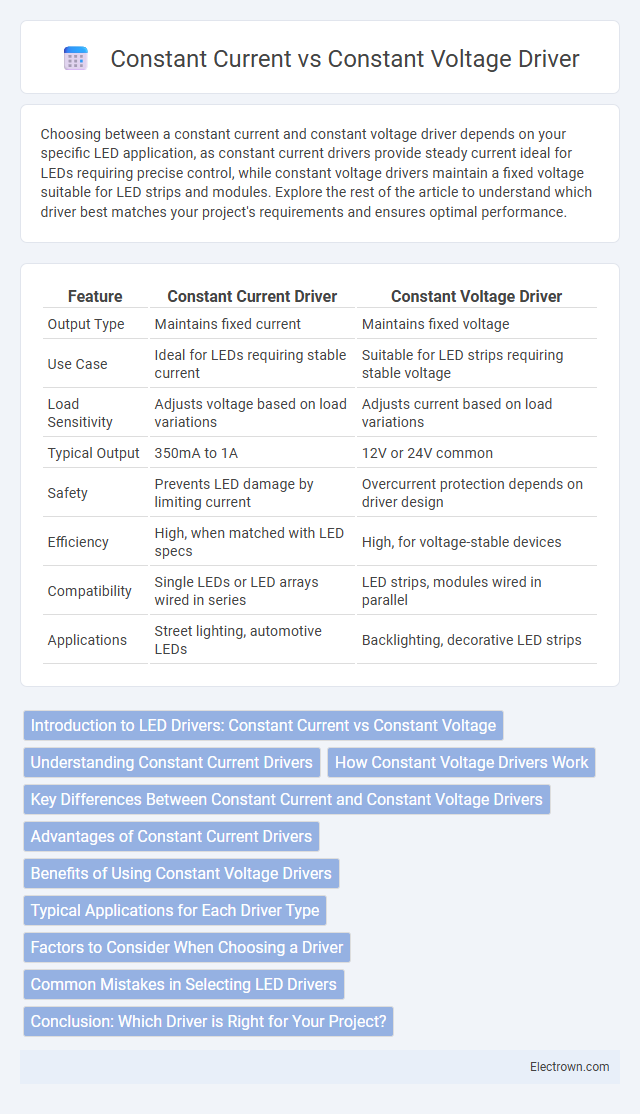Choosing between a constant current and constant voltage driver depends on your specific LED application, as constant current drivers provide steady current ideal for LEDs requiring precise control, while constant voltage drivers maintain a fixed voltage suitable for LED strips and modules. Explore the rest of the article to understand which driver best matches your project's requirements and ensures optimal performance.
Table of Comparison
| Feature | Constant Current Driver | Constant Voltage Driver |
|---|---|---|
| Output Type | Maintains fixed current | Maintains fixed voltage |
| Use Case | Ideal for LEDs requiring stable current | Suitable for LED strips requiring stable voltage |
| Load Sensitivity | Adjusts voltage based on load variations | Adjusts current based on load variations |
| Typical Output | 350mA to 1A | 12V or 24V common |
| Safety | Prevents LED damage by limiting current | Overcurrent protection depends on driver design |
| Efficiency | High, when matched with LED specs | High, for voltage-stable devices |
| Compatibility | Single LEDs or LED arrays wired in series | LED strips, modules wired in parallel |
| Applications | Street lighting, automotive LEDs | Backlighting, decorative LED strips |
Introduction to LED Drivers: Constant Current vs Constant Voltage
LED drivers regulate power to ensure optimal LED performance, with constant current drivers maintaining a steady current to prevent LED damage, and constant voltage drivers supplying a fixed voltage suitable for LED strips or modules. Choosing the right driver depends on your LED configuration and application requirements, as mismatched drivers can reduce lifespan and brightness consistency. Understanding these drivers helps you achieve efficient, reliable lighting tailored to your specific LED setup.
Understanding Constant Current Drivers
Constant Current Drivers regulate a fixed current output to power LED lighting, ensuring consistent brightness and preventing damage caused by current fluctuations. These drivers are essential for LEDs connected in series, as they maintain uniform current flow regardless of changes in voltage. By delivering a stable current, Constant Current Drivers enhance LED lifespan and performance in various industrial and commercial applications.
How Constant Voltage Drivers Work
Constant voltage drivers maintain a fixed voltage output, typically 12V or 24V, regardless of variations in load or input voltage. They regulate power supply to LED strips and lighting systems by supplying a stable voltage, allowing current to vary according to connected devices. This ensures consistent brightness and protects LED circuits from voltage fluctuations.
Key Differences Between Constant Current and Constant Voltage Drivers
Constant current drivers maintain a fixed current output regardless of voltage changes, making them ideal for LEDs that require precise current control to avoid damage. Constant voltage drivers supply a steady voltage output, suited for lighting systems like LED strips that need consistent voltage but varying currents. The key differences lie in their electrical regulation methods: constant current drivers regulate amperage to match LED specifications, while constant voltage drivers provide fixed voltage, allowing for flexible load configurations.
Advantages of Constant Current Drivers
Constant current drivers provide precise control of LED current, ensuring consistent brightness and preventing thermal runaway. They optimize LED lifespan by maintaining a stable current regardless of voltage fluctuations. Your LED lighting system benefits from enhanced reliability and energy efficiency with these drivers.
Benefits of Using Constant Voltage Drivers
Constant voltage drivers provide steady voltage output, ensuring optimal performance and safety for LED lighting systems designed to operate at fixed voltages. These drivers reduce the risk of overcurrent damage and simplify installation by maintaining a consistent voltage level across the entire circuit. By choosing a constant voltage driver, you enhance the reliability and lifespan of your LED lights, especially in applications requiring multiple fixtures connected in parallel.
Typical Applications for Each Driver Type
Constant current drivers are typically used in LED lighting systems that require precise current regulation, such as street lights, automotive headlights, and high-power LED chips, ensuring consistent brightness and longevity. Constant voltage drivers are best suited for LED strip lights, signage, and low-voltage lighting fixtures where voltage stability is crucial and current variations are tolerated. Selecting the appropriate driver type depends on the LED's electrical characteristics and the desired application for optimal performance and energy efficiency.
Factors to Consider When Choosing a Driver
Choosing between a constant current and constant voltage driver depends on the LED type, application requirements, and power supply compatibility. Constant current drivers are ideal for LED arrays requiring precise current regulation to prevent damage, while constant voltage drivers suit installations with multiple parallel LED modules needing stable voltage. Your decision should consider factors such as LED specifications, wiring configuration, and environmental conditions to ensure optimal performance and longevity.
Common Mistakes in Selecting LED Drivers
Selecting LED drivers often involves confusion between constant current and constant voltage types, leading to mismatched driver loads and reduced lifespan. Using a constant voltage driver for LEDs designed for constant current can cause overcurrent issues, while the opposite results in unstable brightness and potential damage. Properly matching the LED specifications with the correct driver type ensures optimal performance, longevity, and energy efficiency.
Conclusion: Which Driver is Right for Your Project?
Choosing between a constant current and constant voltage driver depends on the specific requirements of your LED project, including the type of LEDs and application needs. Constant current drivers are ideal for LEDs that require a fixed current to maintain brightness and prevent damage, while constant voltage drivers suit setups with multiple LEDs in parallel needing stable voltage. Your decision should prioritize matching the driver type to the LED specifications to ensure optimal performance and longevity.
Constant Current vs Constant Voltage Driver Infographic

 electrown.com
electrown.com